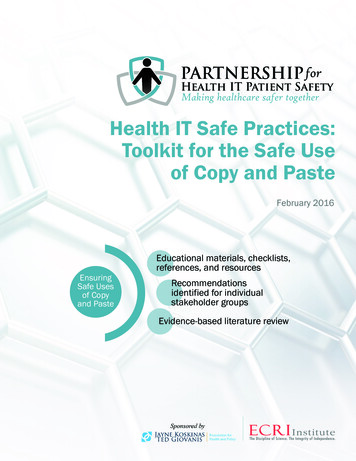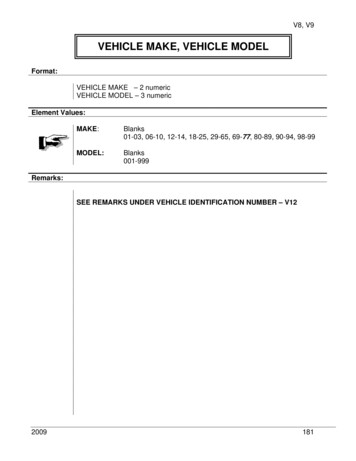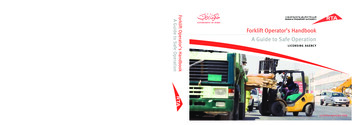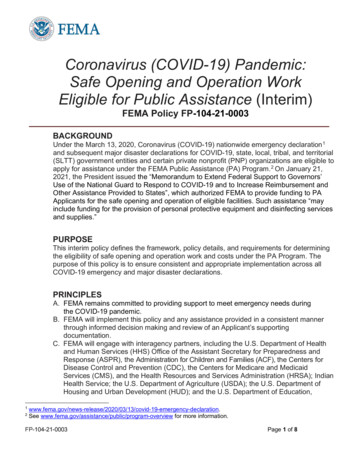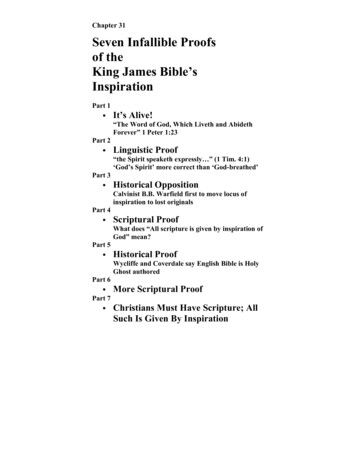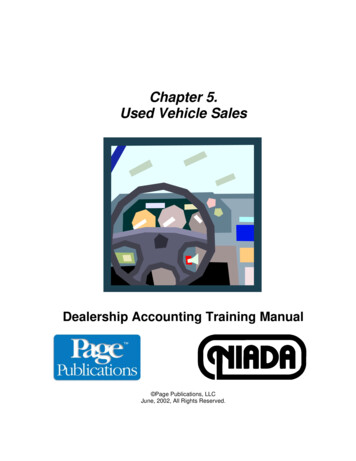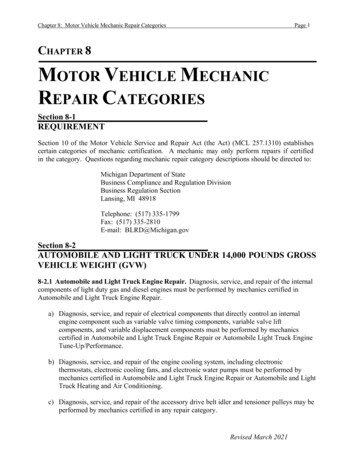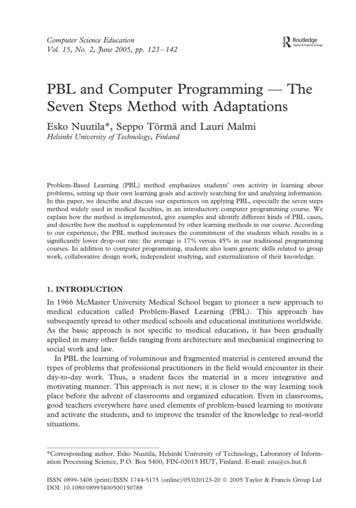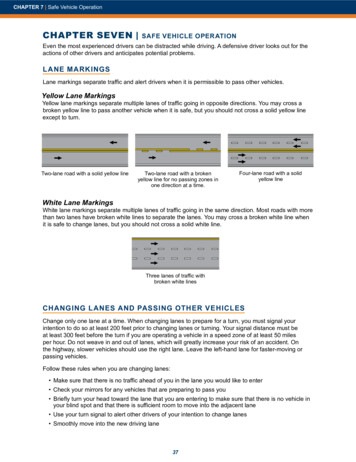
Transcription
CHAPTER 7 Safe Vehicle OperationCHAPTER SEVEN SAFE VEHICLE OPERATIONEven the most experienced drivers can be distracted while driving. A defensive driver looks out for theactions of other drivers and anticipates potential problems.L ANE MARKINGSLane markings separate traffic and alert drivers when it is permissible to pass other vehicles.Yellow Lane MarkingsYellow lane markings separate multiple lanes of traffic going in opposite directions. You may cross abroken yellow line to pass another vehicle when it is safe, but you should not cross a solid yellow lineexcept to turn.Two-lane road with a solid yellow lineTwo-lane road with a brokenyellow line for no passing zones inone direction at a time.Four-lane road with a solidyellow lineWhite Lane MarkingsWhite lane markings separate multiple lanes of traffic going in the same direction. Most roads with morethan two lanes have broken white lines to separate the lanes. You may cross a broken white line whenit is safe to change lanes, but you should not cross a solid white line.Three lanes of traffic withbroken white linesCHANGING L ANES AND PASSING OTHER VEHICLESChange only one lane at a time. When changing lanes to prepare for a turn, you must signal yourintention to do so at least 200 feet prior to changing lanes or turning. Your signal distance must beat least 300 feet before the turn if you are operating a vehicle in a speed zone of at least 50 milesper hour. Do not weave in and out of lanes, which will greatly increase your risk of an accident. Onthe highway, slower vehicles should use the right lane. Leave the left-hand lane for faster-moving orpassing vehicles.Follow these rules when you are changing lanes: Make sure that there is no traffic ahead of you in the lane you would like to enter Check your mirrors for any vehicles that are preparing to pass you Briefly turn your head toward the lane that you are entering to make sure that there is no vehicle inyour blind spot and that there is sufficient room to move into the adjacent lane Use your turn signal to alert other drivers of your intention to change lanes Smoothly move into the new driving lane37
INDIANA DRIVER’S MANUAL IN.gov/BMVPassing Other VehiclesFollow these rules when you are passing other vehicles: Make sure the passing lane is clear of traffic, as you must return to the right side of the road no lessthan 100 feet before any oncoming vehicle Check behind and to the left of your vehicle to make sure that another vehicle is notattempting to pass you Use your turn signals to alert other drivers of your intention to change lanes Move into the passing lane, accelerate, and continue to move forward until you can see the vehicleyou are passing in your rearview mirror Before returning to the lane in which you were originally driving, use the appropriate turn signalProhibited PassingIt is dangerous and illegal to try to pass other vehicles in the following situations: A solid yellow line is marked on the driver’s side of the center line of the road A yellow, pennant-shaped “No Passing Zone” is posted on the left-hand side of the road, or a whiterectangular “Do Not Pass” sign is posted on the right-hand side of the road When you are driving on or approaching a curve in the road When you are approaching the crest of a hill or grade in the road Within 100 feet of an intersection, railroad crossing, bridge, viaduct, or tunnelBeing PassedIf another vehicle is passing you on the left-hand side of the road, allow the other vehicle to pass safelyand do not increase your speed.RULES FOR SAFE AND LEGAL TURNINGThe first rule for a safe and legal turn is to move into the proper lane well before the turn. To turn left, be inthe far left lane for your direction of travel. To turn right, be in the far right lane for your direction of travel.Turning from a one-way roadto a one-way roadTurning from a one-way roadto a two-way roadTurning from a two-way roadto a one-way roadTurning from a two-way roadto a two-way road38
CHAPTER 7 Safe Vehicle OperationSignaling Intention to TurnYou must give a proper turn signal at least 200 feet before turning or changing lanes. If the postedspeed limit is 50 miles per hour or more, you must give a proper turn signal at least 300 feet beforeturning or changing lanes.The safest type of signal is using the lighted signals used in most vehicles. If, however, one or more ofthese signals is malfunctioning, you may use hand signals. You may not use hand signals on a drivingskills exam.Stop or slowRight turnLeft turnTurning Left from Specially-Designated Center LanesBusy roads on which there are many places a vehicle may make a left turn often have a center lanedesignated solely for the left-turning vehicles.Always be aware that vehicles traveling in the opposite direction may be entering the center lane to turnleft in front of your vehicle. Never use this type of center lanefor passing other vehicles.Designated center lanes for left turns can usually be identifiedby a sign with alternate directional arrows that state “CENTERLANE ONLY” or with pavement arrows, although some centerlanes do not have signs or pavement arrows.Center turn lane with pavement arrowsU-TurnsA U-turn is a maneuver in which a driver changes directionby making a 180-degree turn. It is potentially dangerous andshould only be undertaken when not prohibited by law. Followthese rules when making a U-turn: Always yield right of way to oncoming vehicles andpedestrians Never make a U-turn on a curve in the road or whenapproaching the crest of a hill or gradeMedian U-Turn Intersection Never make a U-turn on an interstate highway. Instead,proceed to the next exit and re-enter the highway in the opposite directionOne place where U-turns are permitted and necessary is at an intersection in which the left-turnmovement is prohibited in the intersection itself, and the left-turn is made after the driver proceedsthrough the intersection and makes a U-turn at an upcoming median opening. These are known asmedian U-turn or J-turn intersections and signs are provided to guide drivers.All-Way StopsThe rules for an all-way stop are like those for a two-way stop: stop and look for oncoming traffic, thenproceed when it is safe to do so. At an all-way stop, the rule is that the first vehicle to stop at the39
INDIANA DRIVER’S MANUAL IN.gov/BMVintersection is the first to proceed through the intersection. However, you may occasionally arrive at anall-way stop sign at the same time as another driver. In such cases the driver to the right has the right ofway. However, if there is any doubt which driver has the right of way or if there is the chance of a crash,it is better to yield the right of way to the other driver.A Yield line markingsNever walk across thecirculating lane(s) in aroundabout to thecenter island.Ck apronYIELDYIELDcTruYIELDYIELDFor multi-lane roundabouts where the circularroadway has more than one lane, drivers shouldknow which lane they need to be in prior to enteringthe roundabout. Drivers should not change lanes inthe circulatory roadway.B Center islandC Raised splitter islandD CrosswalkYIELDRoundaboutsA roundabout is a circular intersection in whichtraffic enters or exits only through right turns andproceeds in a counter-clockwise direction. Whenapproaching a roundabout, incoming traffic alwaysyields to the circulating traffic.DBYIELDSigns, pavement markings, or both are provided toguide drivers to the proper lane in advance of thecirculatory roadway.AYIELDA traffic circle differs from a roundabout in that it mayhave clockwise and counter-clockwise traffic. Theapproaches to the circulatory roadway of a trafficcircle may also be controlled by stop signs instead ofyield signs.Approaching vehiclesmust yield to pedestriansin the crosswalk and totraffic in the roundabout.YIELDLEFT LANERIGHT LANETypical lane control signTwo-lane roundabout(does not reflect all roundabout designs)Some roundabouts have more than one lane, which can present a traffic hazard when smaller vehiclesare driving through the roundabout alongside larger vehicles, such as tractor-trailers and buses.When approaching or driving through a multilane roundabout, drivers must yield the right of way tolarge vehicles driving through the roundabout at the same time. This includes slowing down or stoppingto allow safe passage of the large vehicle through the roundabout.If two large trucks are approaching or driving through a roundabout at the same time, the driver inthe right lane must yield the right of way to the driver in the left lane. This includes slowing down orstopping to allow safe passage of the large truck in the left lane.Following Turning VehiclesWhen following a driver who has signaled an intention to make a turn, or who has slowed down andmay be planning to make a turn, you should slow down and be prepared to stop.SPEED LIMITSIndiana law requires drivers to operate vehicles at the posted speed limit.Exceeding the posted speed limit reduces the driver’s ability to steer safely around curves or objectsin the roadway. It also extends the distance required to stop a vehicle in emergency situations. Crashseverity increases with the speed of the vehicle at impact. The effectiveness of vehicular constructionfeatures, as well as of restraint devices like air bags and safety belts, declines as speed increases.Rural Interstate Highway Speed LimitsRural interstate highways are located outside urban areas with a population of at least 50,000 people.The following speed limit rules apply in these areas: Passenger vehicles may not exceed 70 miles per hour or the posted speed limit40
CHAPTER 7 Safe Vehicle Operation Trucks that have a declared gross vehicle weight greater than 26,000 pounds may not exceed 65miles per hour or the posted speed limitOn a rural state divided highway, vehicles may not exceed 60 miles per hour or the posted speed limit.Urban Speed LimitsUrban areas have a population of at least 50,000 people. The following speed limit rules apply in these areas: On an urban interstate highway, vehicles may not exceed 55 miles per hour or the posted speed limit On a non-divided state highway, vehicles may not exceed 55 miles per hour or the posted speed limit On county roads, vehicles may not exceed 55 miles per hour or the posted speed limit In most urban residential areas, vehicles may not exceed 30 miles per hour or the posted speed limit In alleys, vehicles may not exceed 15 miles per hour or the posted speed limitSchool Zone Speed LimitsIf you are driving near a school, you must slow down to the lower, posted speed limit for the school zone.Common hours for school zone speed limits are 7 a.m. to 4:30 p.m., Monday through Friday or whenschool speed limit beacons are flashing. However, local authorities may also establish lower speed limitsfor school zones whenever children are present.Reduced Speed Limits in Highway Work ZonesWork site speed limits are always at least 10 miles per hour below the maximum established speed limitfor the area. Drivers must adhere to the posted speed limit in a work site. Some work site speed limitsare in effect only when flashing and others are in effect at all times.School Bus Speed LimitsWhen not driving on an interstate or state highway, the maximum speed limit for a school bus is 40miles per hour unless the posted speed limit is lower. The maximum speed limit for a school bus on aninterstate or highway is 60 miles per hour or the posted speed limit.Reduce Speed in Dangerous ConditionsExcessive speed, even when conditions are ideal, is dangerous and increases the likelihood of anaccident. Driving at the posted speed limit or in excess of it during the following roadway conditions iseven more dangerous:BR AKING AND FOLLOWING DISTANCESThe following chart provides an indication of how fast or how far a vehicle travels at 35, 55, and 70miles per hour. Bad weather and poor visibility Unsafe vehicle conditions Slick or icy roads Impaired physical condition Driving with worn tires Hazardous conditions on road surfaceA good rule for drivers to follow is to stay at least two to three seconds behind the vehicle ahead. Whenfollowing a vehicle, watch for it to pass a fixed object and estimate how much time elapses before youpass the same object.Speed35 mph55 mph70 mphFeet traveled in one second51.380.7102.7Traffic lanes in one second2.645.1Seconds to travel a football field5.83.72.9Many factors affect a vehicle’s ability to stop: Weight of vehicle Type and condition of brakes41
INDIANA DRIVER’S MANUAL IN.gov/BMV Type and condition of tires Physical condition of pavement Slickness of pavement Grade of roadSkiddingSudden turns, lane changes, or hard braking can cause a vehicle to skid. The procedure for correctinga skid is the same for both front-wheel-drive vehicles and rear-wheel-drive vehicles.If your vehicle begins to lose traction or the rear wheels begin sliding sideways, ease off the gas pedal. Donot make a fast turn away from the direction of the skid and do not steer too far, which could cause a spin.If your vehicle has conventional brakes, turn the steering wheel in a controlled manner in the directionthe rear of the car is sliding. When you regain traction, straighten the vehicle and proceed slowly.If your vehicle has an anti-lock brake system (ABS), keep your foot on the brake pedal, maintainingfirm and continuous pressure, while steering normally. Do not pump the brakes. A mechanical sound ornoise and vibration or increased resistance in the brake pedal indicates your ABS is working.RolloverRollover crashes account for nearly one-third of all passenger vehicle fatalities. You can reduce yourrisk of a rollover while driving: Avoid panicked steering– Many rollovers occur when drivers overcorrect their steering as apanicked reaction to an emergency. At highway speeds, overcorrecting or excessive steering cancause the driver to lose control, which can force the vehicle to slide sideways and roll over. Know proper maneuvering– If your vehicle leaves the roadway, do not turn back onto thepavement right away. Ease up on the gas pedal. When it’s safe to do so, gradually turn back ontothe road. Maintain your tires– Improperly inflated and worn tires inhibit your ability to maintain vehiclecontrol, which is the most important factor in reducing the chance of rollover. Load vehicles properly– You can find the maximum safe load for your vehicle, as well as properload distribution, in your vehicle’s owner manual. Use caution on rural roads– Rollovers are more likely to occur on undivided, two-way roads ordivided roads with no barriers. If a vehicle goes off a rural road, the vehicle can roll over if it strikesa ditch or embankment, or is tripped by soft soil. Slow down on curves and ramps – Frequently advisory speeds are provided at these locations –these advisory speeds should not be exceeded.The rollover risk of a 15-passenger van increases dramatically as the number of occupants increases.Other risks include inexperienced drivers, improperly sized and/or inflated tires, and incorrectly loadedcargo and/or passengers that could affect the vehicle’s center of gravity.FUEL ECONOMYFuel consumption increases steadily above 45 miles per hour, with passenger cars and light trucksusing approximately 50 percent more fuel traveling at 75 miles per hour than at 55 miles per hour.You can maximize your fuel economy: Drive more efficiently by driving sensibly, observing the speed limit, avoiding hauling cargo on yourroof and removing excess weight from your vehicle. Avoid rapid acceleration or sudden stops. Keep your vehicle in shape by properly maintaining your engine, keeping your tires properly inflatedand using the recommended grade of motor oil. Plan and combine trips. Your fuel economy is worse when your engine is cold than when it iswarmed up. Several short trips taken from a cold start can use twice as much fuel as a longer,multipurpose trip covering the same distance.42
CHAPTER 7 Safe Vehicle OperationTIRE PRESSURE AND TRE AD DEPTHTire PressureTires have been known to lose up to 1 pound per square inch (psi) every month, so check all tires,including your spare, once a month or before a long trip. Here’s how: Purchase a trusted pressure gauge Open your car door and on the inside jamb there should be a sticker with your vehicle’srecommended psi. Check your tires “cold”– before you’ve driven or at least three hours after you’ve driven. Insert pressure gauge into the valve stem on your tire The gauge will “pop” out and show a measured number Compare the measured psi to the psi found on the sticker inside the driver’s door of your vehicle orin owner’s manual– DO NOT compare to the psi on your tire’s sidewall If your psi is above the number, let air out until it matches; if below, add air (or have a retailer helpyou) until it reaches the proper numberTread DepthOnce every month, or before you embark upon a long road trip, check your tires for wear and damage.One easy way to check for wear is by using the penny test.1. Take a penny and hold Abraham Lincoln’s body between your thumb and forefinger2. Select a point on your tire where the tread appears the lowest and place Lincoln’s head intoone of the groovesIf any part of Lincoln’s head is covered by the tread, you’re driving with the legal and safe amount oftread. If your tread gets below that (approximately 1/16 of an inch), your car’s ability to grip the road inadverse conditions is greatly reducedDRIVING IN UNCERTAIN WE ATHER CONDITIONSWinter DrivingDriving in winter weather presents a number of dangers due to ice, snow, and very cold temperatures.Always clear your windows before driving.Ice on the roadway is a potentially dangerous condition that can cause a vehicle to lose traction.Snow, especially when mixed with significant wind, poses a number of problems for drivers. Visibilitymay be substantially reduced. Watch for drifting snow, particularly in rural areas where only a fewinches of snow can cause roads to become impassable. Always watch for icy conditions, too, whenthere is snowfall on the ground, particularly at intersections, and use your headlights to be seen byother drivers. Be aware that moisture on ramps, bridges, and overpasses may occasionally freezebefore other sections of the driving roadway. Stay a safe distance behind snowplows.Always allow your vehicle’s engine plenty of time to warm up before driving in very cold conditions.Drive with a full tank of gas so that if stranded, the heater can remain in use for as long as possible.Brush the snow off your headlights and taillights frequently.Consider carrying a winter survival kit in your vehicle that includes sand or strips of carpet for traction,booster cables, blankets, shovel, flashlight, extra clothing, candles, matches, nonperishable snack food,and bottled water.RainWet roadway surfaces can be dangerously slick, especially immediately following a rainfall. When youare driving on wet roads, your vehicle is actually traveling on a thin layer of oil, dirt, and water whichcan lead to hydroplaning.43
INDIANA DRIVER’S MANUAL IN.gov/BMVHydroplaning increases with speed and at any point your tires may be in contact only with the oil, dirt,and water. If this happens, there is no friction to brake, speed up, or turn, and a gust of wind, a changeof road level, or a slight turn can cause you to lose control of your vehicle.Do not drive on bald or badly worn tires. Slow down when there is heavy rain, standing water, or slushon the road. After driving through water puddles, test your brakes by pumping them. Doing so will help todry them. If the water is deeper than your tire treads, slow down. Use your headlights to be seen by otherdrivers.FogFog can greatly reduce your visibility of other vehicles, pedestrians, and traffic signals. Drive cautiouslyand at reduced speeds. Do not use high headlight beams. Low headlight beams better illuminate the roadand objects ahead. If fog closes in completely, and visibility is reduced to near zero, carefully pull off theroad as far as possible and stop. Headlights and flashing emergency signals should be used while drivingin fog.High WindsStrong winds have a significant effect on high-profile vehicles (e.g., vans and sport utility vehicles). Beaware of such conditions and take appropriate action for your safety.Flash FloodingFlash flooding causes more deaths than any other roadway weather event each year. Be especiallyalert at night or when driving on unfamiliar roads. If you are caught in a storm or come upon ahazardous situation, follow these rules: Do not drive around traffic barricades or past road closed signs Watch for bridges, culverts, and roadbeds that may be washed away or undermined by floodwaters Do not drive where water is over the road, because the depth of the water is not always obviousand the water may hide washouts If your car stalls in a flooded area, abandon it as soon as possible, because flood waters can riserapidly and sweep a car and its occupants awayDRIVING AT NIGHTDriving at night presents a number of potential problems which can be made worse if you do not haveexperience driving at night or in dangerous conditions. Drivers are more likely to be fatigued whiledriving at night and may have a higher risk of accidents. Be prepared to stop driving if you experienceany signs of drowsiness listed on page 45.VisibilityPedestrians, road markings, and other vehicles are more difficult to identify and recognize at night.Under nighttime driving conditions, you should reduce normal speed, especially on unfamiliar roads.The glare of oncoming headlights may also reduce vision. To avoid glare, do not look directly into thelights of an approaching vehicle, and instead focus on the right side of the road.HeadlightsDrivers must use headlights between sunset and sunrise as well as at any other time in which visibilityis less than 500 feet. When headlights are on, lower headlight beams must be used when approachingwithin 500 feet of an oncoming vehicle or when following within 200 feet of the rear of another vehicle.IMPAIRED AND DANGEROUS DRIVINGDrowsy DrivingDriving drowsily can increase your risk for accidents. Accidents related to drowsy driving can be veryserious, leading to severe injuries or even death. Nationally, an estimated 16.5% of all fatal motor vehicle44
CHAPTER 7 Safe Vehicle Operationcrashes involved a fatigued driver. Studies have shown that going 18 hours without sleep leaves a driverequally impaired to a driver with a .08 Blood Alcohol Content (BAC), which is the legal alcohol limit.Among the most susceptible to driving while overly exhausted are shift workers, parents, individualstaking sedative medications, and those who have an untreated sleep disorder. Although anyone canmake the fatal mistake of driving without adequate rest, young adults age 16-29 are at the highest risk,accounting for 64 percent of fatigue-related accidents.Be prepared to stop driving if you are unable to stay alert or experience any of the followingsigns of drowsiness: Falling asleep at stop lights Yawning, rubbing eyes, watery eyes, or heavy eyelids Difficulty remembering the last few miles or minutes driven Missing road signs or exits Changing lanes unexpectedly Head nodding or dropping Driving off the road or hitting the rumble strips Failing to maintain a constant speedIf you drive while drowsy, you may become slower to respond to road and traffic conditions. You maystruggle to process complex information coming from different places at once. You may also becomecareless when making driving decisions, have trouble paying attention, or actually fall asleep while driving.How to Prevent Drowsy DrivingDo not drive if you are tired. The best way to reduce drowsiness is to get more sleep. Pull over to a safearea as soon as you can and take a short nap.If possible, avoid driving during times you feel sleepy. Let a well-rested person drive. Considercarpooling, using public transportation, calling a taxi, or asking a family member or friend to drive you.DISTR ACTED DRIVINGDriver distraction is a growing concern in Indiana and a major contributing factor in many crashes.Distracted driving is any activity that takes your eyes off the road, hands off the steering wheel, or yourmind off of driving. Distracted driving activities include things like using a cell phone, texting, and eating.Indiana law specifically prohibits the use of a telecommunications device, while operating a motorvehicle. The only exceptions to this prohibition are when hands-free communication is enabled or if thetelecommunications device is being used to contact 911 for a bona fide emergency.Texting is the most alarming distraction. Sending or reading a text takes your eyes off the road for 5seconds. At 55 mph, that’s like driving the length of an entire football field with your eyes closed. InIndiana, while driving it is illegal to text, call, or otherwise use telecommunication devices such as cellphones unless they are hands free.AGGRESSIVE DRIVINGApproximately one-third of all Indiana traffic fatalities occur due to “dangerous driving.” A dangerousdriving accident is any collision stemming from a driver taking one or more of the following actions:aggressive driving, disregarding a signal, or speeding.According to Indiana law, a person engages in aggressive driving if, during one episode of continuousdriving of a vehicle, the person does or commits at least three of the following: Following a vehicle too closely45
INDIANA DRIVER’S MANUAL IN.gov/BMV Unsafe operation of a vehicle Overtaking another vehicle on the right by driving off the roadway Unsafe stopping or slowing a vehicle Unnecessary sounding of the horn Failure to yield Failure to obey a traffic control device Driving at an unsafe speed Repeatedly flashing the vehicle’s headlightsDRIVING ON RUR AL ROADSDriving on rural roads can be more hazardous than driving on a paved interstate or city street. Ruralroads may be narrower in width and consist of paved asphalt, dirt, or gravel surfaces.Gravel–Stopping and turning is more difficult on loose gravel because your traction is reduced.When traction is reduced, skidding can occur. You must slow down earlier to reduce your risk ofskidding through a turn or stop.Dirt–During dry periods, dirt roads may be very dusty. The dust can reduce your visibility. Use yourlow beam headlights to make yourself more visible to other drivers.Narrow Bridges and Roads– Some bridges and roads may be narrow. You should use cautionwhen approaching or passing other vehicles on narrow roads or bridges. Always watch for narrowbridge signs and be prepared to stop for other vehicles.Steep Hills or Crests–Before approaching the crest of a steep hill, slow down, move to the rightside of the road, and watch for oncoming vehicles. Never attempt to pass another vehicle whenapproaching a steep hill or crest.Reduced Sightlines– Cultivated crops such as corn may reduce your ability to see vehiclesapproaching intersections and oncoming vehicles on curvy roads.DRIVING ON INTERSTATE HIGHWAYSGood judgment and timing are needed to merge smoothly with fast-moving traffic on highways. Whenyou enter an interstate on-ramp, stay to the right and increase your speed in the acceleration lane toallow your vehicle to merge with traffic when your path is clear. Drivers already on the interstate shouldmake allowances for those entering. However, drivers entering an interstate must yield the right of wayto vehicles on the interstate.It is unsafe to back up on an interstate highway to reach a missed exit. If you miss an exit, you mustdrive to the next exit. It is illegal for any vehicle, other than an emergency vehicle or a highwaymaintenance vehicle, to make a U-turn by crossing the median or crossover of an interstate highway.Except in the event of an emergency or a disabled vehicle, do not stop or park a vehicle on theshoulder of an interstate highway.Trucks are restricted to the right lane on sections of interstate with two lanes in one direction andrestricted to the right two lanes of interstate with three lanes or more in one direction.46
CHAPTER 7 Safe Vehicle OperationWORK ZONESFlashing arrow boards are often used to indicate a lane closure or “crossover.” In these cases, lanemarkings on the road, traffic cones, barrels or barricades will outline the path the vehicle must follow. Aflashing arrow board not indicating a direction either way is a signal to use caution, but does not requirea driver to move to another lane.Move or merge rightMove or merge right or leftMove or merge rightCautionFlagger SignalsAt some work sites, one or more flaggers are posted at each end of the work zone to control traffic flow.You must stop when a flagger extends a fluorescent orange/red flag in a horizontal position into the lineof traffic. You may proceed at a reduced speed only when directed to by the flagger.If a flagger uses a signal paddle, you must stop or proceed slowly according to the “STOP” or “SLOW”message displayed on the sign.In some cases, Automated Flagger Assistance Devices are used to enable the flaggers to be positionedout of the lane of traffic. These devices display a “STOP” or a “SLOW” sign just like the flagger-heldsign paddle or use red and yellow lights.StopStopSlowProceedAutomated Flagger Assistance DeviceWork Zone Safety Driving TipsWork zones pose dangers both for drivers and for the workers. Be respectful of these dangers andexercise caution whenever traveling in a work zone: Stay alert. Look for reduced speed limits, narrow driving lanes and highway workers. Pay attention. Work zone signs will state exactly what to expect ahead. Merge early. If merging at first sight of signs, traffic will generally flow more smoothly. At some47
INDIANA DRIVER’S MANUAL IN.gov/BMVlocations traffic is encouraged to merge towards the lane closure, th
Common hours for school zone speed limits are 7 a.m. to 4:30 p.m., Monday through Friday or when school speed limit beacons are flashing. However, local authorities may also establish lower speed limits for school zones whenever children are present. Reduced Speed Limits in Highway Work

